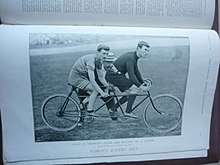Arthur Adalbert Chase
Arthur Adalbert Chase (born 1874) was a British professional cyclist.[1]
North Road Club
Chase was a member of the North Road Club when he began riding in 1887. He won his first race 1893, taking first place 13 times out of 14 events he entered. By the end of 1894, he had set a number of time and distance records, and toured Europe, the U.S., and Australia.[2]
Champion cyclist
Chase was a champion cyclist from 1896 to 1902.[3] After retiring from the professional cycling scene, he teamed up with his brother F. W. Chase to build motorcycles.[4][5] Many years after the motorcycle enterprise, he lodged a patent for an exhaust silencer.[6]
Cycling in 1898 was not without hazard, as Arthur found out to his detriment after a five-shilling fine.[7] Not deterred by his run-in with the law, nine months later he was suspended for road racing.[8] He seems to have kept his nose clean for another 4 years, until getting yet another fine at Doncaster Borough Court.[9] Even years later when Arthur had moved to Southend, he was still newsworthy for being in court.[10]
Cycling achievements
- June 1896 – World Record for 50 miles, taking 1 hour 45 minutes 38.6 seconds.[11]
- August 1896 – Gold Medal at the ICA Track Cycling World Championships in Copenhagen, Denmark.
- August 1897 – Silver Medal at the ICA Track Cycling World Championships in Copenhagen, Denmark.
- June 1899 – England 'world record' for standing half mile of 54 seconds.[12]
- July 1899 – World Record at Crystal Palace for 2 miles, in 3 minutes 25.2 seconds.[13]
- August 1900 – World Record at Crystal Palace.[14]
- September 1900 – Winner of the 100 km (62 mi) race at the Paris Olympics. Note at this time only amateurs were allowed an official olympic title.[15]
- September 1901 – Fastest standing half-mile, 1 minute 38 seconds.[16]
- September 1901 – Fastest mile in the UK, taking 1 minute 27.8 seconds.[17]
- February 1903 – Beat T. Hall at Alexandra Palace Velodrome, a 1-mile flying start in 2 minutes 3.4 seconds.[18]
Pacing machine
Chase had been using pacing tandems in the past, and even rode behind an electric pacing tandem when he went up against the famous French cyclist Bouhours in Paris in 1898. [19]
The use of a fast pacer was not considered cheating at that time, and this must have motivated Chase to have a special pacer custom-made to his design. He commissioned a UK firm to build the machine at the start of 1899, a tandem with a rear-mounted 1.75 hp deDion engine. Both riders pedalled, the front one being responsible for steering, the rear for control of the engine. This pacer was capable of 39 mph at top speed.[20]
Tandems
Although Chase was a champion solo cyclist, he also tried his hand at tandem racing, along with Walters who would ride up front.[21]

Chase also worked with his brother in building Chase Brothers Motorcylces.
References
- "Arthur Adalbert Chase, www.cyclingarchives.com/". Retrieved 26 May 2015.
- Ogdens cigarette card. F&J Smiths. 1899. p. 45.
- Sportfolio. George Newnes Ltd. 1896. p. 31.
- Roy Bacon and Ken Hallworth (2004). The British Motorcycle Directory – Over 1,100 Marques from 1888. The Crowood Press.
- Henshaw (2007). The Encyclopedia of the Motorcycle. The Crowood Press.
- US2122086, "Silencer for internal combustion engines"
- London Standard. 19 April 1898. Missing or empty
|title=(help) - Walsall Advertiser. 14 January 1899. Missing or empty
|title=(help) - Yorkshire Post and Leeds Intelligencer. 31 March 1903. Missing or empty
|title=(help) - "World's Champion Cyclist - Southend Charge Dismissed". Essex Newsman (3485). 31 October 1936. p. 4. Retrieved 22 February 2019 – via British Newspaper Archive.
- Lloyds Weekly Newspaper. 14 June 1896. Missing or empty
|title=(help) - "Cyclists and Cycling". Table Talk. Melbourne. 30 June 1899. p. 19. Retrieved 4 May 2015 – via National Library of Australia.
- Pall Mall Gazette. 31 July 1899. Missing or empty
|title=(help) - Birmingham Daily Post. 1 August 1900. Missing or empty
|title=(help) - Cycling at the 1900 Summer Olympics
- "Arthur Smyth". Australian Town and Country Journal. Sydney. 11 February 1903. p. 39. Retrieved 4 May 2015 – via National Library of Australia.
- "SPORTING NOTES". The Shoalhaven Telegraph. NSW. 4 September 1901. p. 12. Retrieved 4 May 2015 – via National Library of Australia.
- "SYDNEY THOUSAND CARNIVAL". The Sydney Morning Herald. 14 February 1903. p. 14. Retrieved 4 May 2015 – via National Library of Australia.
- "AN ELECTRIC PACED RACE". The Referee. Sydney. 8 June 1898. p. 6. Retrieved 4 May 2015 – via National Library of Australia.
- "Notes". Sydney Mail and New South Wales Advertiser. 11 February 1899. p. 353. Retrieved 4 May 2015 – via National Library of Australia.
- "The Cycling World Illustrated a Journal deLuxe". 9 September 1896: 563. Cite journal requires
|journal=(help)